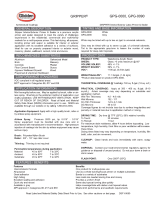Page is loading ...

• NORTH AMERICA • 600 Mid Florida Drive Airport Industrial Park of Orlando, Florida 32824 • Tel. (407) 240-4000 Fax (407) 240-4046
• CARIBBEAN & SOUTH AMERICA • Urb. Aponte #5, San Lorenzo, Puerto Rico USA 00754 • Tel. (787) 736-4221 Fax (787) 736-5313
• CENTRAL AMERICA • Zona Industrial Bes, lote #4, El Coyol de Alajuela, Costa Rica • Tel. (506) 2438-2257 Fax (506) 2438-2162
Prime Coat™ WP-038 Rev. 06/ 2016
Uses:
Prime Coat™ is excellent for new, previously painted or glossy surfaces. For use
under water-based top coats on exterior and interior areas, and non-stained
woods. As a stain sealer primes white to hide most colors. To use in Concrete,
brick, prepared wood, drywall board, fiber cement, EIFS, etc.
Notice: The technical data contained herein are true and accurate to the best of our
knowledge. Published technical data and instructions are subject to change
without prior notice.
S.D.S.: Available upon request.
Surface Preparation:
All surfaces must be dry, clean, sound and free of contaminants such as dirt,
grease, mildew, oil, rust, concrete curing agents, chalk, laitance, efflorescence,
loose or badly cracked paint. Remove all contaminants by washing surfaces with
an appropriate cleaner, sanding, scrapping and/or using a pressure washing
machine. Allow the surface to dry before proceeding.
Cracks and holes: Have to be clean and dry. With a putty knife apply Lanco
®
Siliconizer™ Crack Filler into crack and 2 inches to both sides, patch all holes with
Lanco
®
Spackling Compound. Let dry thoroughly 24 hours.
Mildewed surfaces: Any existing mildew on the surface must be completely killed
and removed prior to the application of primer or paint. Any mildew not removed
can continue to grow through the new finish. Using a long handled brush scrub
mildewed surfaces with a mixture of one part of household bleach and three parts
of warm water. Rinse completely and let dry.
Concrete surfaces: Mortar plaster, stucco and concrete block must be cured and
hard. Remove any surface contaminant, releasing agents and curing agents or
efflorescence, etc. Surface must have a safe pH level under 9 prior to the
application of paint or primer.
Previously painted surfaces: All surface contaminants such as oil, grease, mill
scale, dirt, mold, mildew mortar, efflorescence and sealer must be removed to
assure sound bonding to the previous finish. Old coatings that are partially
removed or loose by blistering, rupture or scratching should be removed to
provide a sound surface.
Eforescence: Is a white powdery, crystal-like deposit that is visible on masonry
surfaces. It must be removed using a solution of 1 part of muriatic acid and 3 parts
of water. Use long handled brush. Rinse completely.
Wood and plywood: Sand rough areas and prime properly. Maximum acceptable
moisture content prior to coating new wood should be under 16%.
Method of Application:
Stir thoroughly before using. Paint always on shaded side of the building. Do not
dilute paint, use as supplied. Do not apply when surface or air temperature is
below 50 ˚F or if rain is expected within 5 hours. Apply product with brush, roller or
sprayer. Apply generously with a full brush or roller and avoid excessive brushing
or spreading too thinly. Typical standard practice recommends intermixing when
working with more than one container of the same color, to ensure color
consistency.
Test pH levels: Levels of pH should be under 9 prior to the application of any paint
or primer. If pH level is above 9 but below 13, apply Lanco
®
100% Acrylic Roof &
Wall Primer/Sealer AS-210 as per instructions prior to the application of additional
primers and/or finish coats.
Mixing and thinning: Mix always thoroughly before application. Thinning is not
recommended, if necessary use only 8oz. of water per gallon of this product.
Brush: Use a good quality nylon PA-1982 or polyester brush PA-1999.
Roller: Use a Lanco
®
All-Purpose 3/8” Nap Roller PA-566. Apply generously, but
avoid excessive brushing or reworking of painted areas, do not apply or spread too
thinly.
Spray: Spray equipment should be capable of maintaining a pressure of 700-1000
psi with a tip of 0.015 to 0.019. Spray and back roll on rough or porous surface to
achieve required film build. Apply two coats with overnight drying between coats
to minimize pinholes on the surface is recommended. See equipment’s
manufacturer recommendation.
Precaution: Do not apply when air or surface temperature is below 50˚F(10˚C).
Apply liberally,but do not overspread. Stop painting at least two hours before you
expect dew to form or the temperature to fall below 50˚F(10˚C).
Important: It is important that you apply one coat of primer and two full coats of
paint to achieve the warranty protection.
Limited warranty: The manufacturers liability in connection with the sale of this
product extend only to the replacement price if it should fail to comply with quality
standards or specifications.
Caution: Harmful if swallowed. Contains acrylic resin. In case of eye contact, flush
thoroughly with water. Do not rub eyes. In case of skin contact, flush area
immediately with clean water. If swallowed, do not induce vomiting. Consult a
physician immediately. Use only with adequate ventilation. Adequate ventilation
required when sanding or abrading the dried film. Always use (NIOSH/MSHA
TC21C or equivalent.) Goggles are recommended while handling the product. This
product may contain chemicals known to the State of California to cause cancer
and birth defects or other reproductive harm. Keep out of reach of children.
Warning! If you scrape, sand, or remove old paint, you may release lead dust.
Lead is toxic. Exposure to lead dust can cause serious illness, such as brain
damage, especially in children. Pregnant women should also avoid exposure.
Wear a NIOSH-approved respirator to control lead exposure. Clean up carefully
with a HEPA vacuum and a wet mop. Before you start, find out how to protect
yourself and your family by contacting the National Lead Information Hotline at
1-800-424-LEAD or log on to www.epa.gov/lead. For chemical emergency call
ChemTrec 1-800-424-9300. Protect from freezing.
/



